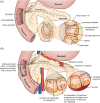ACVIM consensus statement on pancreatitis in cats
- PMID: 33587762
- PMCID: PMC7995362
- DOI: 10.1111/jvim.16053
ACVIM consensus statement on pancreatitis in cats
Abstract
Background: Pancreatitis in cats, although commonly diagnosed, still presents many diagnostic and management challenges.
Objective: To summarize the current literature as it relates to etiology, pathogenesis, diagnosis, and management of pancreatitis in cats and to arrive at clinically relevant suggestions for veterinary clinicians that are based on evidence, and where such evidence is lacking, based on consensus of experts in the field.
Animals: None.
Methods: A panel of 8 experts in the field (5 internists, 1 radiologist, 1 clinical pathologist, and 1 anatomic pathologist), with support from a librarian, was formed to assess and summarize evidence in the peer reviewed literature and complement it with consensus clinical recommendations.
Results: There was little literature on the etiology and pathogenesis of spontaneous pancreatitis in cats, but there was much in the literature about the disease in humans, along with some experimental evidence in cats and nonfeline species. Most evidence was in the area of diagnosis of pancreatitis in cats, which was summarized carefully. In contrast, there was little evidence on the management of pancreatitis in cats.
Conclusions and clinical importance: Pancreatitis is amenable to antemortem diagnosis by integrating all clinical and diagnostic information available, and recognizing that acute pancreatitis is far easier to diagnose than chronic pancreatitis. Although both forms of pancreatitis can be managed successfully in many cats, management measures are far less clearly defined for chronic pancreatitis.
Keywords: cat; diagnosis; etiology; gastroenterology; management; pancreas; pancreatitis; pathophysiology.
© 2021 The Authors. Journal of Veterinary Internal Medicine published by Wiley Periodicals LLC. on behalf of the American College of Veterinary Internal Medicine.
Conflict of interest statement
Dr. J. Steiner serves as the director of the Gastrointestinal Laboratory at Texas A&M University, which offers measurement of fPLI concentration on a fee‐for‐service basis. Dr. Steiner also serves as a paid consultant and speaker for Idexx Laboratories, Westbrook, ME, the manufacturer of the Spec fPL and SNAP fPL assays and for ISK, Osaka, Japan, the manufacturer of fuzapladib. None of these organizations influenced the outcome of this consensus statement. None of the other authors declare any conflict of interest.
Figures









Comment in
-
Letter regarding "ACVIM consensus statement on pancreatitis in cats".J Vet Intern Med. 2021 Jul;35(4):1648-1649. doi: 10.1111/jvim.16165. Epub 2021 May 21. J Vet Intern Med. 2021. PMID: 34021508 Free PMC article. No abstract available.
-
Letter regarding "ACVIM consensus statement on pancreatitis in cats".J Vet Intern Med. 2021 Jul;35(4):1644-1645. doi: 10.1111/jvim.16168. Epub 2021 May 21. J Vet Intern Med. 2021. PMID: 34021622 Free PMC article. No abstract available.
References
-
- De Cock HEV, Forman MA, Farver TB, et al. Prevalence and histopathologic characteristics of pancreatitis in cats. Vet Pathol. 2007;44:39‐49. - PubMed
-
- Banks PA, Bollen TL, Dervenis C, et al. Classification of acute pancreatitis—2012: revision of the Atlanta classification and definitions by international consensus. Gut. 2012;62:102‐111. - PubMed
-
- Steer ML, Waxman I, Freedman S. Chronic pancreatitis. N Engl J Med. 1995;332:1482‐1490. - PubMed
-
- Watson P. Pancreatitis in dogs and cats: definitions and pathophysiology. J Small Anim Pract. 2015;56:3‐12. - PubMed
Publication types
MeSH terms
LinkOut - more resources
Full Text Sources
Other Literature Sources
Medical
Miscellaneous

